How to make a Chatbot with Artificial Intelligence (AI)?
Bài đăng này đã không được cập nhật trong 6 năm
The world is slowly moving towards intelligent business systems that can make important decisions or perform vital actions on behalf of humans while offering a personalized experience. AI Chatbots are the latest rage in the current business technology scene ranging from E-commerce systems to hospitality management systems. The key advantages are anytime and anywhere interactions which give the business global access to potential customers.
These intelligent software systems analyze previous conversations and study patterns using what is known as Artificial Neural Networks (ANN) to exhibit a more human-like response to queries. Some chatbots even flash the current user’s preferences based on previous conversations to give a more realistic touch to the interaction. Using a combination of Natural Language Processing (NLP), Vector Machines, Heuristics, and ANN, chatbots are designed to respond like intelligent humans.
The nub of these intelligent responses is not the chatbots, rather it is the intelligence quotient of these computer programs that is so intriguing.
Let us take a look into the important aspects of AI Chatbots and How they are built.
What is an AI Chatbot?
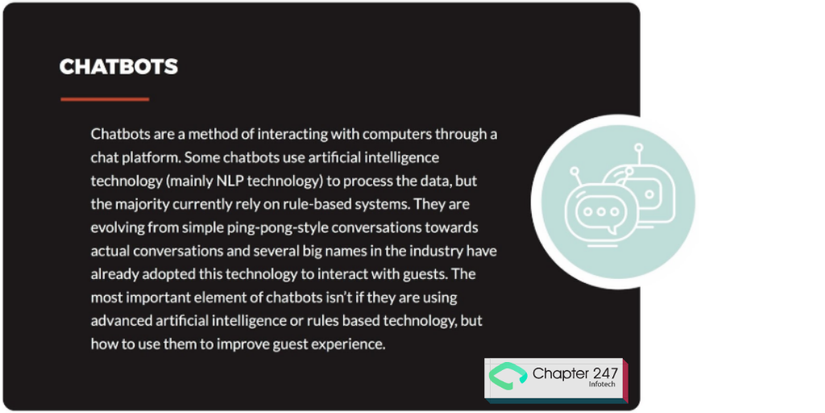 An AI Chatbot is a computer program or an Artificial Intelligence software that can simulate a real human conversation with real-time responses to users based on reinforced learning. AI Chatbots either use text messages, voice commands, or both. AI robots use a natural language to communicate with Artificial Intelligence features embedded in them.
An AI Chatbot is a computer program or an Artificial Intelligence software that can simulate a real human conversation with real-time responses to users based on reinforced learning. AI Chatbots either use text messages, voice commands, or both. AI robots use a natural language to communicate with Artificial Intelligence features embedded in them.
AI robots can be addressed as talk bots, IM bot, artificial conversation entity, etc.
The main aim of creating AI chatbots is to help customers make better informed decisions.
How Do AI Chatbots Know What a User Wants?
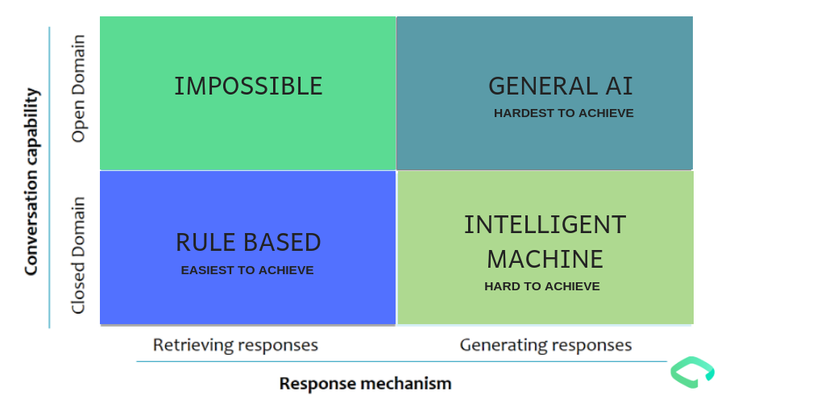
There are two ways in which AI Chatbots are designed to understand the user’s requirements. One is with a limited set of guidelines and internal structuring being applied to the way the AI robot must respond. This is done when the set of questions posed by the human users is preordained with keywords and mapped to relevant responses. This mechanism needs no real-time responses from the interactive agent. Such AI bots are called limited chatbots.
An example would be the Automated Banking Bot that asks the caller a set of questions to know what he/she wants. If the caller gives a command that is out of scope, then the AI bot would either repeat the instruction or transfer the call to a human banking assistant.
The second method of how an AI chatbot interacts is by knowing what a user is looking for and producing real-time responses based on progressive conversations or increased learning. Though this mechanism is still evolving due to its complexity, certain applications like Amazon’s Alexa, Google Assistant, WeChat, and Facebook AI Chatbot are on the pathway towards dynamic responses based on human behavioral and preferential traits. Self-learning is what helps these entities understand the human mind and gain appropriate information efficiently to produce convincing responses. These AI Chatbots are also called Intelligent Chatbots.
Does the Chatbot Know How to Meet User Requests?
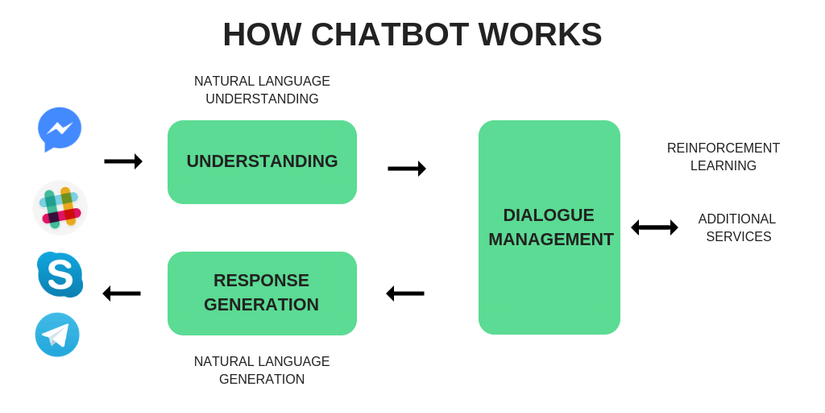
Though AI chatbots have been developed to meet user requests with suitable and relevant responses, the challenge lies in mapping the requests to the most intelligent response that would convince the user. Intelligent planning with the help of heuristics and ANN aids an AI chatbot that learns to progress from one user request to another to come up with an intelligent response before completing the task.
Planning is a process that relates to a sequence of actions performed by the AI chatbot leading to a structured conversation that involves acknowledgment, questions, and information relay. Internally the AI Bot has to perform intelligence building to form structured responses.
When it comes to complex tasks, the AI bots rely on an action sequence to establish the primary goal of the user with the help of memory of the past user responses and the mapping of user requests to valid business responses stored in the response repository. These intelligent bots may either map responses based on similar request history information of the same or different user, or create intelligent responses based on the keywords in the request.
How Do We Know for Sure If the Chatbot is Intelligent?
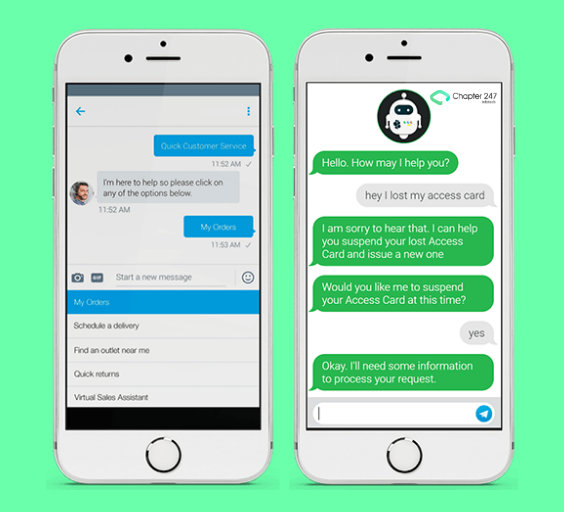
Chatbots are built to assess a problem and come up with an intelligent solution by working autonomously. The following steps determine if the AI chatbot that learns is intelligent:
Firstly, the AI chatbot has to identify the goal for a specific situation Then it has to process the available information to see if the goal can be realized, if not, it has to request for more information this involves sensing the environment where it resides in order to perform a set of given tasks Based on this information it has to go on recursive mode to see if the goal can be realized or not. This involves thinking or making decisions based on the environment. Usually, the requests or responses from users are converted into a machine-understandable form and stored in the form of parameter values in the information base from which it is retrieved from time to time A system of continuous knowledge-building is followed by the interactive system which influences its learning capacity. This knowledge base helps the chatbot learn faster, identify relevant information for faster response time, and provide the most convincing response based on its decision-making caliber built over time with the help of ANN The AI chatbot then acts by carrying out its decisions A certain level of predictive analysis is built over time with the increasing number of human interactions and queries stored in the information repository which helps the AI chatbot that learns to plan ahead about the queries that would come from the user’s end Set guidelines and machine learning help the AI chatbot respond in real-time realistically. The Chatbot is only as intelligent as its programming code. The more flexible and intricate the code, the more realistic and relevant the response of the AI chatbot. What Do You Want the Chatbot to Do?
What Do You Want the Chatbot to Do?
Making your chatbot more responsive by infusing the intelligence program in it depends on what you want the chatbot to do. If your chatbot is designed just to respond to queries with a fixed set of responses via text or voice, it acts as a collector of a certain amount of information from the user and responds with a valid predefined answer that adheres to a business model.
A more evolved and intelligent form of chatbot is programmed to interpret what the user is requesting and performs the task real-time based on progressive self-learning. This type of intelligent chatbot is called Helper chatbot and is the best AI chatbot till date. It can help users make reservations, buy products, seek information, etc.
On the other hand, the collector bot can be made more intelligent by enhancing its response presentation skills that are based on the information that it has collected.
You may also want to read about: The Benefits of Chatbot in Business Solutions.
How would you want the Conversation to progress?
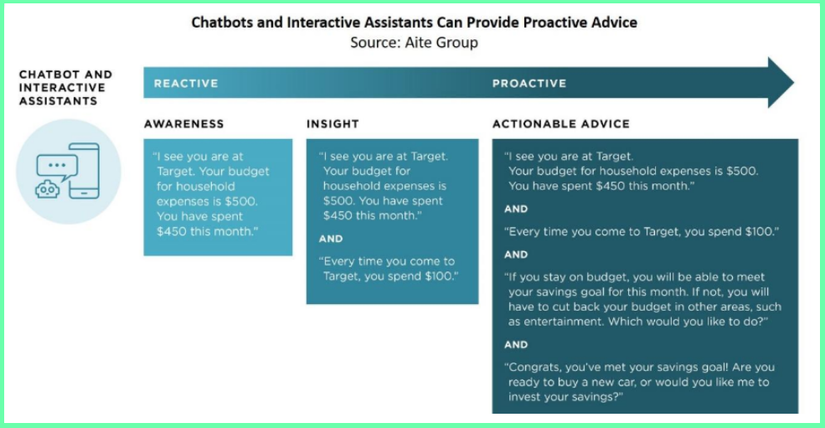 Some users look for domain-specific solutions where there is an expected output mapped to corresponding input, while others look for general discussions. There are more emotionally evolved chatbots like Eviebot and Boibot that respond to intelligent questions with a fair quotient of humanlike emotions.
Some users look for domain-specific solutions where there is an expected output mapped to corresponding input, while others look for general discussions. There are more emotionally evolved chatbots like Eviebot and Boibot that respond to intelligent questions with a fair quotient of humanlike emotions.
Intelligent interactions of AI chatbots include responding to varied topics and discussions through voice or text like normal human interactions. These Chatbots are labeled as ‘open-domain’ and operate by picking the best responses or formulating responses by analyzing the information stored in the database. Depending on if you are looking for a specific answer or want to be given varied responses your conversation must progress with a ‘closed-domain’ or ‘open-domain’ AI chatbot.
Can Challenges Be Foreseen in Building an AI Chatbot?
Building in intelligence for an AI chatbot has a lot of aspects that need to be considered like context-awareness building, personality development, internal information parsing, emotional quotient, positive and negative response calibration, impact evaluation, etc.
Context Integration into the intelligence system of the AI Chatbot is challenging and complex. It is also very important in defining the way the interactions are performed by the AI bots. Physical and linguistic contexts are considered for achieving sensible responses. Embedding conversations into a vector format needs a lot of effort in programming. Timestamp and location details about the users need to be integrated with the Chatbot. Coherent Responses include giving the same answers to questions that are identical in terms of semantics but put in a different way. Like, “What is your name?” and “What can I call you?” The programming efforts to achieve coherence is challenging. Chapter247 has incorporated coherent responses in its chatbot application programming. Performance Assessment of open-domain AI chatbots becomes challenging since their responses are dynamic and in-the-moment based on real-time intelligence and information mining. The human judgment of the AI bot’s performance may vary from person to person which is challenging to assess. This is comparatively easier to gauge for domain-specific AI Bots that perform input and output mapping. Read Intention Training is important in order to provide relevant responses to individual queries for which the chatbot has to be trained. The diversity required to handle multiple scenario-based questions is challenging to program into AI Bots. In the near future, companies would be using chatbots for their marketing activities for customer retention and better business conversions. Is an intelligent platform ‘the’ alternative?
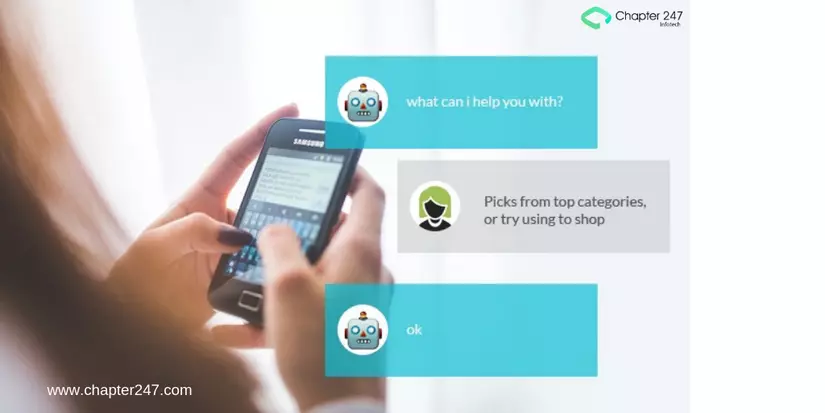
In a world of intelligent communications, chatbots have become effective business catalysts that connect with the customers to attain valuable business-generating information. Chatbots like Google Assistant have been built on intelligent platforms that act as information agents. The chatbots are sensors on these platforms that perform based on instructions given by them.
The platform analyzes the user goal collects information, mines the stored information, processes it, and converts the information to a human understandable form.
Chapter247 Infotech has been pioneering in Customer Service using AI Chatbots just like the social platforms through the application of Artificial Intelligence expertise in Machine Learning, NLP, Deep Learning, and Data Science Services. To know more about how we have driven businesses globally through automated communication using AI Chatbots, Call Us Today.
All rights reserved